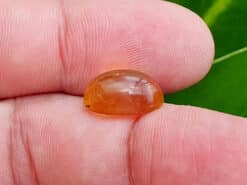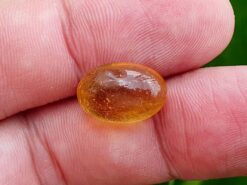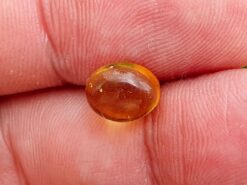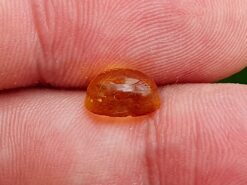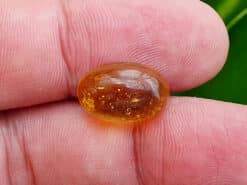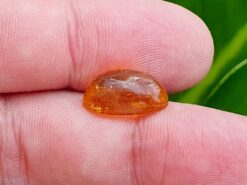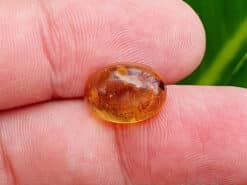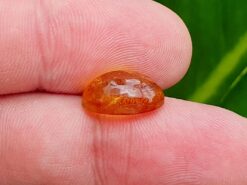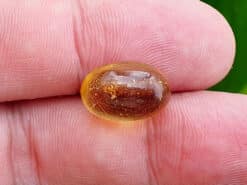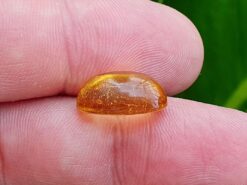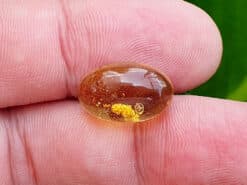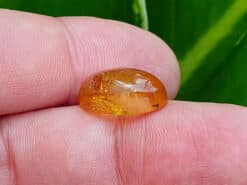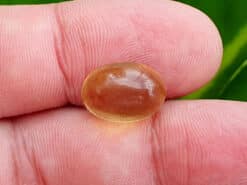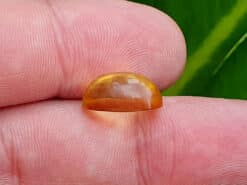Amber

Amber crystal stone fossils are classified as gemstone.
Buy natural amber in our gem shop
fossilized tree resin
Amber is fossilized tree resin, which has been appreciated for its rich hues and natural allure since Neolithic times. Prized from antiquity to the present day for its luminous warmth, it has been fashioned into a wide range of decorative objects. Traditionally used for jewelry, it was also believed to hold healing properties in various folk practices. With its formation process spanning millions of years, amber’s origin as resin preserves a window into the past, often housing ancient plant fragments or small creatures.
Historically, this gem has played a significant role in trade routes, especially around the Baltic region, where it was sought after for ornamentation and cultural ceremonies. Over time, artisans developed advanced techniques to carve and shape the stone into beads, amulets, and even intricate sculptures. The subtle, natural perfume that arises when amber is rubbed or gently heated further adds to its enchanting character.
Five classes
There are five distinct classes of amber crystal stone, defined by their chemical makeup. Because amber originates as a soft, sticky resin, it can encapsulate tiny animal or plant material as inclusions, revealing snapshots of prehistoric life. Amber found within coal seams is referred to as resinite, while the term “ambrite” specifically applies to material discovered in New Zealand’s coal deposits. Each class of amber reflects variations in the original resin-producing trees and their surrounding environmental conditions.
Composition
Amber crystal stone or gemstone fossils is heterogeneous in composition, yet it generally consists of several resinous substances that are more or less soluble in alcohol, ether, and chloroform. These are intertwined with an insoluble bituminous material. Amber is effectively a
macromolecule formed by free radical polymerization of labdane-related diterpenes such as communic acid, cummunol, and biformene.
As the organic resin matures through vast stretches of time, further polymerization, isomerization, crosslinking, and cyclization occur. These natural chemical reactions gradually transform once-sticky resin into a solid gem with varying degrees of transparency, color, and hardness. When heated above 200 °C, amber decomposes, producing a fragrant oil and leaving behind a black residue known as amber colophony. This residue, also called pitch, can be dissolved in linseed oil or oil of turpentine to create varnishes and lac-type coatings, demonstrating amber’s use beyond mere adornment.
Polymerization
Molecular polymerization, spurred by high pressures and temperatures in overlying sediment, turns the resin into copal first. Sustained heat and pressure then cause terpenes to be driven off, culminating in the fully formed amber. For resin to make this transformation without degrading, it must be resistant to microbial activity and environmental factors like intense sunlight, rain, and temperature fluctuations. Most resin exuded by trees is broken down relatively quickly, so the processes that preserve resin long enough to evolve into amber are remarkably special and relatively rare.
Certain trees excrete resin with unique chemical properties, helping it remain intact for millennia. In coastal or swamp-like conditions, the resin can be swiftly covered by sediments, slowing decay. The lack of oxygen beneath layers of soil further prevents the breakdown of this organic material, setting the stage for its slow conversion into one of nature’s most mesmerizing substances.
Amber crystal stone or gemstone fossils meaning and healing properties benefits
The following section is pseudo-scientific and based on cultural beliefs.
Amber is often considered one of the most soothing stones, said to gently diffuse feelings of anger or stress. Some believe it aids in transforming negativity into clarity and calm, promoting thoughtful and balanced communication. In many traditions, it symbolizes ancient wisdom, as it captures remnants of prehistoric ecosystems. Followers of holistic practices sometimes use it to connect with a sense of warmth and stability. While these spiritual or healing attributes are not scientifically proven, the stone’s enduring beauty and organic origin continue to fascinate enthusiasts worldwide.
In addition, many people cherish amber for its perceived emotional support. By representing nature’s patience—resin hardened over eons—it can encourage wearers to find serenity in difficult circumstances. This sense of grounding is frequently incorporated into meditation or mindfulness techniques, where the stone may serve as a tactile reminder of tranquility and a long-view perspective on life.
FAQ
What is amber made of?
Amber is a fossilized resin from ancient forests. It does not derive from simple tree sap, but rather from aromatic plant resin that once dripped down trunks or filled internal crevices. This resin frequently captured seeds, leaves, or even tiny insects along the way, preserving them for millions of years.
Where can amber be found?
This fascinating stone is discovered in locations across the globe—from Alaska to Madagascar. Major deposits exploited for jewelry and scientific study are concentrated in the Dominican Republic, the Baltic region of Europe, and Myanmar (formerly Burma). Each source can feature slightly different colors and clarity.
What does amber mean?
The name “amber” signifies fossilized tree resin or the vivid orange-red hue associated with it. In English-speaking cultures, it has also been adopted as a personal name, often for girls. This dual usage underscores the gem’s longstanding connection to aesthetic appeal.
What does amber do spiritually?
In various belief systems, amber is lauded as a powerful healer and cleanser for body, mind, and spirit. It is said to help dispel feelings of melancholy, spark creativity, and boost self-confidence. By encouraging wise decision-making, it is believed to foster balance, patience, and a deeper awareness of life’s flow.
Why is amber expensive?
Amber’s value typically increases when it contains rare inclusions such as well-preserved insects or other prehistoric specimens. High-quality transparency, rarity of color, and the gem’s overall condition also affect pricing.
What is the rarest color of amber?
Blue is the rarest color of amber, though it is relatively new to the commercial gem market. Under most conditions, blue amber can resemble ordinary yellow-brown material, but when viewed in specific lighting, it shows a distinct, luminous blue glow.
Is amber heavy or light?
Genuine amber is notably lightweight and slightly warm to the touch, due to its unique chemical composition and organic origins. In contrast, glass imitations feel heavier and cooler, aiding collectors in differentiating real amber from counterfeits.
What does amber help with?
Amber bracelets and adornments have long been associated with alleviating rheumatic discomfort and soothing aching joints and muscles. The gem is also claimed to help ease anxiety and fatigue. Folk remedies often recommend it for various types of pain or as a means to channel protective energy.
Is amber good luck?
Many traditions hold that amber brings good fortune and wards off malevolent influences. The vivid gold and orange tones are believed to stabilize and harmonize higher energies within the body, fostering an atmosphere of protection and equilibrium.
Who can wear amber stone?
There are no strict limitations regarding who can wear amber. As a reputed healing stone with minimal negative connotations, it can be worn in various forms: as rings, necklaces, bracelets, or even in children’s teething accessories. Its warmth and mild nature make it a popular choice across different ages and cultures.


